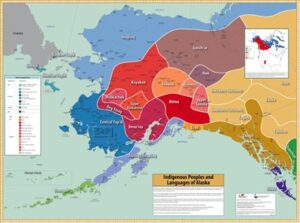Due to some technical difficulties, we’re reposting some old blogs.
November is Native American Heritage Month. This month is dedicated to their culture and heritage. This will highlight information around commercial tobacco use among Alaska Natives. Some information on American Indians is included as well.


Source: Alaska Native Heritage Center. Map represents the Indigenous People and Languages of Alaska
Alaska Native and American Indian Facts1,2,3
- Did you know there’s 573 federally recognized Indian Nations and other tribes in the US?
- 228 of those are in Alaska– that’s about 40% of all nations and tribes!
- Alaska is also home to the highest proportion of Alaska Natives and American Indians. Oklahoma is #2, with about 10.5% less individuals who are Alaska Native or American Indian.
Commercial Tobacco Use4,5
Why is “commercial” included in the title? This is to pay respect to the American Indian communities that use traditional tobacco products. Alaska Natives generally do not use traditional tobacco. Commercial tobacco differs from traditional in that commercial tobacco:
- Is produced for recreational use by companies
- Contains chemical additives and is linked to death and disease
- Sometimes erroneously used for ceremonies
- Sold for profit
Usage trends:
- Alaskan Native adults are noticeably more likely to use cigarettes and smokeless tobacco products, which includes Iq’mik/Blackbull/Dediguss
- Alaskan Native women are also more likely to use tobacco during pregnancy
- Like adults, Alaskan Native youth are noticeably more likely to use cigarettes and smokeless tobacco products
- Alaska Native adults use e-cigarettes at similar rates to most race/ethnic groups.
- Alaska Native youth are less likely to use e-cigarettes than their Hispanic and white counterparts
- Secondhand hand smoke exposure can occur. There isn’t a percentage available for Alaska Native People.
Commercial Tobacco Related Health Impacts6,7
This doesn’t highlight every health impact. Just most of what is measured for Alaska Natives and American Indian specifically.
Lung Cancer (State and National data)
- The rate of new lung cancer cases among Alaska Natives and Americans Indians in Alaska is 85 per 100,000. This is higher than that of white Alaskans (53 per 100,000) and white Americans (41 per 100,000).
- About the same percentage of lung cancer cases are diagnosed at an early stage among Alaska Natives and American Indians in Alaska and their white counterparts.
- Nationally, the five-year survival rate for Alaska Natives and American Indians is lower than white Americans. (No state level data is available for AN/AI.)
Asthma (National data only)
- AN/AI adults are more likely to currently have asthma than white Americans. However, they are about as likely to ever been told they have asthma.
- AN/AI Indian children are 2x as likely to ever been told and to currently have asthma than white children.
Other Health Impacts (National only)
- AN/AI are more likely to have heart disease and high blood pressure
- AN/AI have higher infant mortality rate and more likely to die from complications related to low birth weight
- Smoking and secondhand smoke exposure during pregnancy are linked to these
- Smoking can worsen anxiety, stress, and depression
- Suicide is a leading cause of death among AN/AI
- If you are having thoughts of suicide or are experiencing a mental or emotional distress, call or text 988 for help
Iq’mik8,9
For those who aren’t aware: Iq’mik is a form of smokeless tobacco, traditionally used by the Cu’pik and Yu’pik people of Western Alaska. Some may refer to it as Blackbull, Dediguss or Lusky. Iq’mik is seen as a way of life rather than a cultural tradition.
Iq’mik is made from a tobacco leaf and ash of burned birch punk fungus or willow or alder bark. Punk and alder ash change the chemistry of smokeless tobacco and can make more nicotine reach your rain and bloodstream faster than normal. Iq’mik has been found to have high levels of nicotine and cancer-causing chemicals.
Iq’mik raises the risk of:
- Nicotine poisoning
- Seizures
- Dizziness
- Fast heartbeat
- Throwing up
- Oral health issues (gum disease, cavities, staining of teeth, and toothy decay)
- Cardiovascular issues (high blood pressure, heart attack, stroke, and heart disease)
- Cancers (mouth, colon, lung, bladder, larynx, pancreas, and esophagus)
- Complications during pregnancy and childbirth
Want to Quit?
Did you know your body will start healing within minutes of quitting? It’ll continue to do so for years afterwards. It doesn’t matter how long or how much you’ve smoked. Your body will heal.
- Alaska State Quitline: if you’re ready or thinking about quitting. Enroll online, phone call (1-800-QUIT-NOW), or text READY to 200-400.
- Alaska Native Tribal Health Consortium: offers free cessation services to patients at Alaska Native Medical Center and ANTHC employees. Provides regional resources that may offer cessation resources.
- Live Vape Free: teens can text VAPEFREE to 873373 to learn about vaping and get support to quit.
- Not For Me: another teen resource for those wanting to quit any kind of tobacco product
Other Resources
- Benefits of Quitting | Smoking & Tobacco Use | CDC: information on the benefits of quitting
- SavedByTheScan.Org: if you smoke or are a former smoker, you may be eligible for lung cancer screening. Use this site to learn more and see if you are eligible.
- Home – ANCSA Regional Association: leads you to information regarding the history of Alaska Native and the 12 Alaska Native Corporations, which serve the Alaska Native communities that fall within the corporation’s territory.
Concerned About Second Smoke or Smoking?
Those affiliated with multiunit housing (property managers, owners, residents, funders etc.) can get free assistance from the American Lung Association in Alaska. Reach out to SmokefreeHousingAK@Lung.Org with any questions or concerns!
References
- November 2022 Native American Heritage Month – Lewis & Clark National Historic Trail (U.S. National Park Service) (nps.gov)
- Alaska Region | Indian Affairs (bia.gov)
- Demographics | NCAI
- Alaska Tobacco Facts 2021
- Traditional vs. Commercial | Keep It Sacred (itcmi.org)
- State Data | Alaska | American Lung Association
- American Indian/Alaska Native – The Office of Minority Health (hhs.gov)
- Iq’mik Brochure. Developed by the Yukon-Kuskokwim Health Corporation with support from the Alaska Native Tribal Health Consortium and State of Alaska Department of Health and Social Services.
- Chemical Analysis of Alaskan Iq’mik Smokeless Tobacco – PMC (nih.gov)



